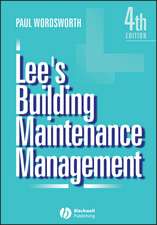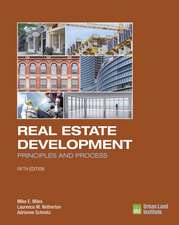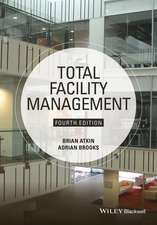Economics of Property Management: The Building as a Means of Production
Autor Herman Tempelmans Plat, Frank Heynicken Limba Engleză Hardback – 20 mar 2001
| Toate formatele și edițiile | Preț | Express |
|---|---|---|
| Paperback (1) | 436.14 lei 6-8 săpt. | |
| CRC Press – 30 iun 2020 | 436.14 lei 6-8 săpt. | |
| Hardback (1) | 335.62 lei 5-7 săpt. | |
| CRC Press – 20 mar 2001 | 335.62 lei 5-7 săpt. |
Preț: 335.62 lei
Preț vechi: 590.12 lei
-43% Nou
Puncte Express: 503
Preț estimativ în valută:
64.23€ • 66.35$ • 53.45£
64.23€ • 66.35$ • 53.45£
Carte tipărită la comandă
Livrare economică 19 martie-02 aprilie
Preluare comenzi: 021 569.72.76
Specificații
ISBN-13: 9780750651233
ISBN-10: 0750651237
Pagini: 212
Ilustrații: Approx. 100 illustrations
Dimensiuni: 156 x 234 x 16 mm
Greutate: 0.44 kg
Ediția:1
Editura: CRC Press
Colecția Routledge
ISBN-10: 0750651237
Pagini: 212
Ilustrații: Approx. 100 illustrations
Dimensiuni: 156 x 234 x 16 mm
Greutate: 0.44 kg
Ediția:1
Editura: CRC Press
Colecția Routledge
Public țintă
Professional Practice & DevelopmentCuprins
INTRODUCTION, Structure of the book, Part One: PRODUCTION OF A BUILDING AND USE OF ITS SERVICES, Chapter I.1. Introduction, Chapter I.2. Use of a Building as Means to the Ultimate Goal, Chapter I.3. Service and Technical Solution, Chapter I.4. Levels in the Built Environment, Chapter I.5. Agents in the Building Process, Chapter I.6. Time and Change: Relating Money, Technique and Environment, Chapter I.7. Summary, Part Two: COST CALCULATION AND VALUATION AS BASIS FOR DECISION-MAKING - A THEORETICAL FRAMEWORK, Chapter II.1. Introduction, Chapter II.2. Short Planning Period Versus Long Life Span, Chapter II.3. Annual Cost Calculation, Chapter II.4 Property Valuation, Chapter II.5. Price Changes, Property Value and Annual Costs, Chapter II.6. Economic Description of Buildings and Services: Factory, Dwelling and Bank, Chapter II.7. Summary, Part Three CONSEQUENCES FOR AGENTS IN THE BUILDING PROCESS, Chapter III.1. Introduction, Chapter III.2. User and Facilities Manager, Chapter III.3. Investor and Property Manager, Chapter III.4. Designer and Contractor, Chapter III.5. Project developer, Quantity Surveyor, and Project Manager, Chapter III.6. Authorities, Chapter III.7. Lack of Information, Chapter III.8. Summary
Notă biografică
Herman Tempelmans Plat, Frank Heynick
Recenzii
"My overall view is that this is a very interesting book, which will make an excellent contribution to the market for such texts. " Les Ruddock, Salford University, UK
From the Foreword: "Herman Tempelmans Plat has been among the first scholars who have reflected on the economic consequences of what has become known as the 'Open Building Approach'. What he calls 'horizontal segmentation' takes into account the hierarchical structure of the large project. This book summarises his findings. Its methodology may serve many. Ultimately, builders, designers, manufacturers and users, as much as clients will benefit from a solid economic base for a more flexible and responsive built environment." N. John Habraken, Profewssor Emeritus, Massachusetts Institute of Technology, USA.
From the Foreword: "Herman Tempelmans Plat has been among the first scholars who have reflected on the economic consequences of what has become known as the 'Open Building Approach'. What he calls 'horizontal segmentation' takes into account the hierarchical structure of the large project. This book summarises his findings. Its methodology may serve many. Ultimately, builders, designers, manufacturers and users, as much as clients will benefit from a solid economic base for a more flexible and responsive built environment." N. John Habraken, Profewssor Emeritus, Massachusetts Institute of Technology, USA.
Descriere
The economic analysis of a building is a complex subject and traditionally it has focused on a single aspect of the structure or a single part of the construction process. Dr Tempelmans Plat is a leading proponent of a new methodology which focuses on the building as a stock of services to be supplied over a long lifespan. This method is more realistic since it takes into account the changes in use and the adaptation of the building over its life. This book will be the first to make this method comprehensible to a wide audience of postgraduate students and professionals in the field of construction economics.









